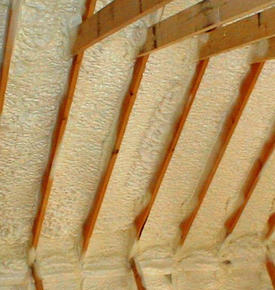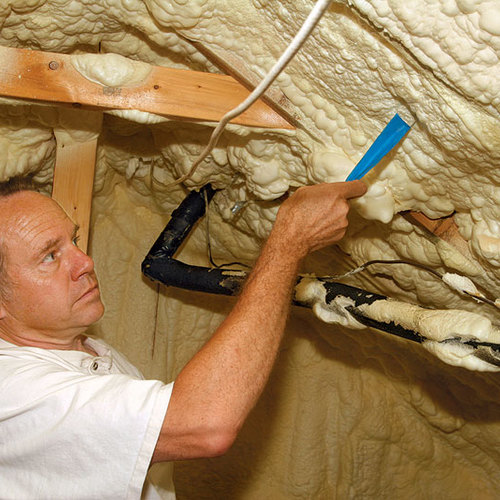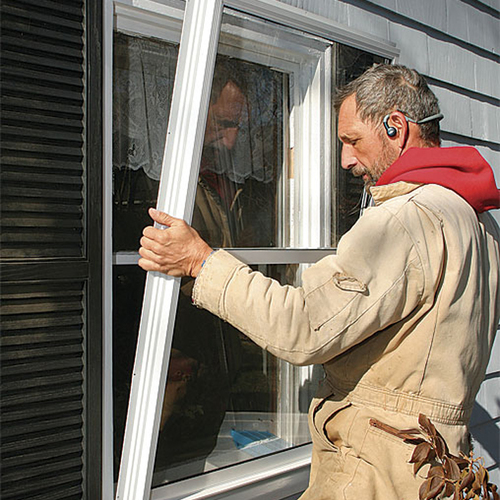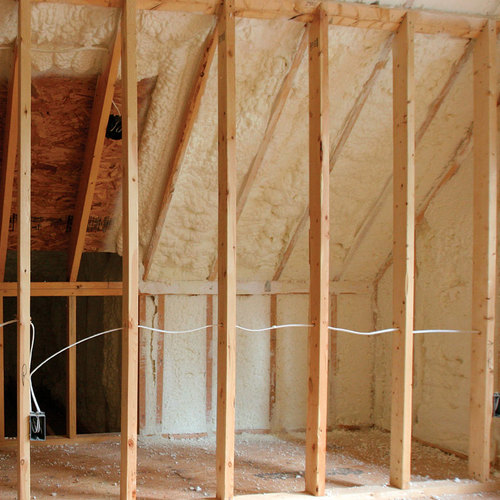
How much is enough?
A homeowner is getting ready to insulate his roof deck but now wonders whether an unvented roof is his best strategy, and whether he's getting good advice from insulation contractors.Image Credit: GBA
Ted Storm is in the midst of a construction project and at a point where he needs to make a decision about attic insulation. The unvented roof consists of standing-seam metal over synthetic felt and oriented strand board (OSB) sheathing. Both HVAC equipment and air ducts will be located in the attic of this house in Climate Zone 4.
Three insulation contractors are unanimous in their recommendation to spray a 6-in. layer of open-cell foam on the bottom of the roof deck.
While the advice is consistent, Storm is having second thoughts about his decision not to vent the roof.
“I’m beginning (maybe a bit too late) to read about unvented roofs and I’m wondering if this is really the best option,” Storm writes in this Q&A post at GreenBuildingAdvisor. “If it isn’t ideal, are we too late to take another route, given our current progress?”
That’s the subject of this week’s Q&A Spotlight.
First, that’s not enough insulation
Armando Cobo is the first to point out that 6 in. of open-cell foam is skimpy, even in the moderate temperatures of Climate Zone 4. The prescriptive requirements of the International Energy Conservation Code call for at least R-38 — and that, Cobo says, means at least 11 in. of open-cell foam.
“Your insulation contractors are planning to install only R-20 to R-22,” GBA senior editor Martin Holladay adds. “That’s not much. In fact, it doesn’t even meet the minimum code requirements (2006 IRC) for Climate Zone 4, which calls for at least R-38.
“If you install less than the code minimum insulation,” Holladay says, “you will pay higher energy bills for as long as you own the building. Many…
Weekly Newsletter
Get building science and energy efficiency advice, plus special offers, in your inbox.

This article is only available to GBA Prime Members
Sign up for a free trial and get instant access to this article as well as GBA’s complete library of premium articles and construction details.
Start Free TrialAlready a member? Log in















6 Comments
2009 IRC
Whether we like it or agree, or not, here it is in the 2009 IRC Code:
Chap. 8 – Roof-Ceiling Assembly
R806.4.5 3 choices to insulate an UNVENTED ATTIC ASSEMBLY
5.1 Air-impermeable ONLY - Closed Cell Foam
5.2 Air-permeable ONLY - Open Cell Foam. In addition to
the air-permeable installed directly bellow the structural sheathing,
rigid board or sheet insulation shall be installed directly above
the roof sheathing as specified on Table R806.4 for condensation control.
5.3 Air-impermeable AND Air-permeable. The air-impermeable insulation
shall be applied in direct contact with the underside of the roof
structural roof sheathing as specified in Table R806.4 for condensation
control. The air-permeable insulation shall be applied directly under
the air-impermeable insulation.
In all three cases, you better have a great moisture management details and good installation.
Unvented Conditioned Attic
This has been discussed numerous times before but I will repeat what I think are some of the critical points. If you are going to condition more space than you can live in, it is going to cost you more money. Convert or build the attic space to be habitable, maybe reduce your footprint, and stop spending all this money just to keep ductwork happy which could be located somewhere else. Foam insulation contractors always seem to want to put less foam in than is required to meet code, or good energy practice. I suspect it is due to the initial cost of installation but a minimal or poorly done job will always cost the homeowner more in the long run. It will always take more insulation to do a sloping roof and end walls than a flat roof or ceiling. It is always a bigger area and also has a greater energy loss just because it is more area. Exposed 2x framing, as shown in the picture, will form a thermal bridge between the conditioned and unconditioned areas giving less effective R value than just that of the insulation. Once these basics are considered, you can then get into the issue of moisture migration and possible entrapment. Finally is that some people get confused and vent the conditioned attic space because they treat it as a traditional attic. I kid you not and I have seen it in an energy audit report to insulate the roof and NOT seal the existing traditional attic venting. This article should have clearly indicated that a vented and unvented attic space are insulated and treated in completely different ways and the two should probably never meet.
Codes and R-Values
So, when are we going to get away from the code specified R-value rule whihc measures conductive heat transfer only at 25F temperature difference (75F-50F) with no wind. This is an unrealistic test and should not be used to measure insulation value for energy efficiency. What about Conduction at 150F-70F or 70F-0F, with a 30mph wind? What about Solar heat gain or thernal mass? None of these factors are considered in the current code which is based on fiberglass R-value. That's the way it's always been so it must be right - Right?
Wrong! There are other ways to meausre convenction, conduction and radiant heat transfer which are approved testing method s. ASTM has a couple of them, but the only issue with these is that none seem to take into account thermal mass into the insulation equation.
So, when it comes down to the unvented roof assembly, you can spray it with an R-20-24 open cell foam and still produce better results than the R-30 filterglass! R-3o fiberglass only performs at an "effective" R-value of R-7-10 over 90% of the time it's installed based on install quality only. Whe you consider that fiberglass performs worse in colder temperatures, worsse with wind blowing through it, worse with convective air loops within the insulation, you have a pretty crappy insulation material. It's probably somewhere down below the R-7-10 effective R-value quoted in the Oak Ridge National Labs research proving it's in-effective R-value by instal only.
So, I for one am all for a more consistent meauremet of insulation and a better baseline that we all have to meet. Enough of this other air-impermeable, air permeable, vapor permeable, vapor impereable type of qualifications of insulation types. Why not just measure it and see how it all does in a more realistic test?
I know there are many "NAY sayers" out there who wil try to shoot this down, but it's the truth. More R-value does not equate to lesser heatting bills. Just because you put more insulation in the attic, doesn't mean you won't have problems. That's where I am suggesting that foam (oppen or closed cell) is a better insulation material and performs better in rela ife circumstances. I have many customers who I've had to convince on the basic principles of the fiam over fiberglass, and everyone who has chosen to agree with me has thanked me later for the lower utility bills, and better insulation material with only an R-20-24.
~Jim Coler
Response to Jim Coler
Jim,
I'm sorry, but you are wrong.
First of all, the reason that R-value measures heat transfer at a defined difference in temperature is to ensure that R-value is strictly defined, and to allow insulation shoppers to compare different products. If we allowed insulation manufacturers to develop their own methods of testing insulation, we would lose the advantages of a standard method.
Second, how can you say that "More R-value does not equate to lesser heating bills?" In fact, it does.
That doesn't mean that you should ignore airtightness. Building codes require builders to address air leakage. When fiberglass batts are installed without attention to air leakage, the batts are installed in a way that violates the code.
If a spray foam installer brags that spray foam is better than an illegal installation of batts, I might agree -- but so what?
806.4
Armando,
You are incorrect sir. Open cell foam is Air-impermeable if sprayed to the proper thickness.
Martin,
I completely agree with your points. The public should have a strictly defined standard to compare insulation products. However, we are due for a much higher standard than R Value. It works great for pipe insulation, but not for buildings. I also agree that manufactures should not influence the test method. It's too bad the pink panther had his way with R value, or we might have ended up with a better test.
First of all, thanks for your
First of all, thanks for your comments Martin. That is exactly what I'm talking about, except a more realistic measurement of the heat transfer with regards to the conductive, convective, and radiant heat transfer with a measure of thermal mass! As far as I know they have been doing this already for windows with ASTM 1424 for years but the walls haven't caught on yet. I'm all for the standardized measurement and code compliance, and that's what I'm asking for. A change in the code recognizing that spray foam does perform differently than fiberglass and cellulose when the other modes of heat transfer are taken into consideration. I mean, how many days a year is it 75F inside your home and only 50F outside with no wind and how much insulation is needed? What about when it's 0F outside and 70F inside and 30mph winds? To top that, what about thermal mass? What happens when you have enough thermal mass to help maintain the thermal temperature thorughout the night and warm back up in the daytime again? I'm not for all manufacturers to go out and write their own codes - I'm actually totally against that!
So, what I meant by my comment about More R-value doesn't mean lesser utility bills, is exactly that. More R-value without addressing the air permeability of the insultaion alreay there does little to reduce your utility bills and can cause other problems such as ice damming by the dust from cellulose sealing up the attic ventilation. I now this is not to code either but this is how it gets done all the time and I've gone in afterwards and fixed it by spraying the undersideof the roofdeck.
Air tightness needs to be addressed -agreed! But the time for fiberglass has come and gone! It's time for the new products out there to a stance in the industry. I mean, look at all the fiberglass companies who have bougt foam companies! They all own one of them and bought into them within the past year or two, They see the writing on the walls, so why can't we?
~Jim Coler
Log in or become a member to post a comment.
Sign up Log in